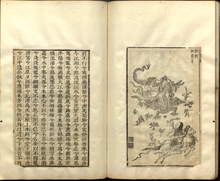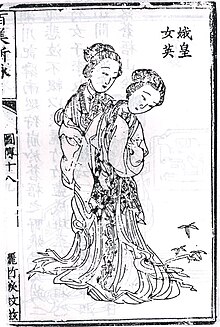
Chinese mythology is mythology that has been passed down in oral form or recorded in literature throughout the area now known as Greater China. Chinese mythology encompasses a diverse array of myths derived from regional and cultural traditions. Populated with engaging narratives featuring extraordinary individuals and beings endowed with magical powers, these stories often unfold in fantastical mythological realms or historical epochs. Similar to numerous other mythologies, Chinese mythology has historically been regarded, at least partially, as a factual record of the past.

Dongting Lake is a large, shallow lake in northeastern Hunan Province, China. It is a flood basin of the Yangtze River, so its volume depends on the season. The provinces of Hubei and Hunan are named after their location relative to the lake: Hubei means "North of the Lake" and Hunan, "South of the Lake".

The Xiang River is the chief river of the Lake Dongting drainage system of the middle Yangtze, the largest river in Hunan Province, China. It is the second-largest tributary in terms of surface runoff, the fifth-largest tributary by drainage area of the Yangtze tributaries. The river flows generally northeast through the provinces of Guangxi and Hunan, its tributaries reaching into Jiangxi and Guangdong.
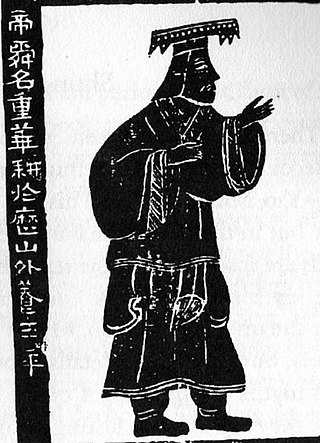
Emperor Shun was a legendary leader of ancient China, regarded by some sources as one of the Three Sovereigns and Five Emperors being the last of the Five Emperors. Tradition holds that he lived sometime between 2294 and 2184 BC. Tradition also holds that those with the surname Hu (胡) are descendants of Emperor Shun. The Duke Hu of Chen, 胡公滿, a descendant of Shun, became the founder of the State of Chen. Later Chen dynasty emperors such as Chen Baxian would also claim descent from Shun.

The Chu Ci, variously translated as Verses of Chu, Songs of Chu, or Elegies of Chu, is an ancient anthology of Chinese poetry including works traditionally attributed mainly to Qu Yuan and Song Yu from the Warring States period, as well as a large number of works composed during the Han dynasty several centuries later. The traditional version of the Chu Ci contains 17 major sections, anthologized with its current contents by Wang Yi, a 2nd-century AD librarian who served under Emperor Shun of Han. Classical Chinese poetry prior to the Qin dynasty is largely known through the Chu Ci and the Classic of Poetry.
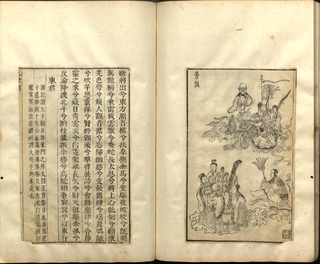
Jiu Ge, or Nine Songs, is an ancient set of poems. Together, these poems constitute one of the 17 sections of the poetry anthology which was published under the title of the Chuci. Despite the "Nine", in the title, the number of these poetic pieces actually consists of eleven separate songs, or elegies. This set of verses seems to be part of some rituals of the Yangzi River valley area involving the invocation of divine beings and seeking their blessings by means of a process of courtship. Though the poetry consists of lyrics written for a performance, the lack of indications of who is supposed to be singing at any one time or whether some of the lines represent lines for a chorus makes an accurate reconstruction impossible. Nonetheless there are internal textual clues, for example indicating the use of costumes for the performers, and an extensive orchestra.
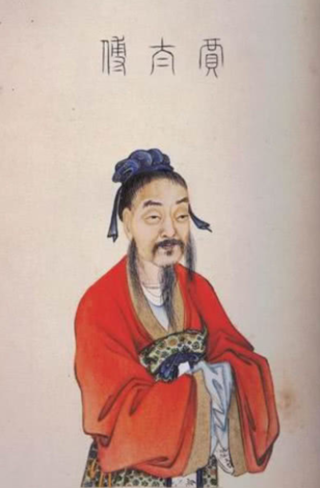
Jia Yi was a Chinese essayist, poet and politician of the Western Han dynasty, best known as one of the earliest known writers of fu rhapsody and for his essay "Disquisition Finding Fault with Qin", which criticises the Qin dynasty and describes Jia's opinions on the reasons for its collapse. In particular, he is famous for his two fu, On the Owl (鵩鳥賦) and his Lament for Qu Yuan (吊屈原賦), and is author of the treatise Xinshu (新書), containing political and educational insights. The Book of Han's Journal on Literature attributes thirty eight writings to him.

Junshan Island is an island in Hunan province in China on Dongting Lake. The name derives from the legend of the Xiang River goddesses. It is 0.96 km2 (0.37 sq mi) in area. It was formerly a Daoist retreat.

The Biographies of Exemplary Women is a book compiled by the Han dynasty scholar Liu Xiang c. 18 BCE. It includes 125 biographical accounts of exemplary women in ancient China, taken from early Chinese histories including Chunqiu, Zuozhuan, and the Records of the Grand Historian. The book served as a standard Confucianist textbook for the moral education of women in traditional China for two millennia.

Wu Yun, better known by his courtesy name Zixu, was a Chinese military general and politician of the Wu kingdom in the Spring and Autumn period. Since his death, he has evolved into a model of loyalty in Chinese culture. He is the best known historical figure with the Chinese family name "Wu" (伍). All branches of the Wu clan claim that he was their "first ancestor".

The Eight Views of Xiaoxiang are scenes of the Xiaoxiang region, in what is now modern Hunan Province, China, that were the subject of the poems and depicted in well-known drawings and paintings from the time of the Song Dynasty. The Eight Views of Xiaoxiang can refer either to various sets of paintings which have been done on this theme, the various verse series on the same theme, or to combinations of both. The Xiaoxiang theme is part of a long poetic and artistic legacy.

Xiaoxiang, also transliterated XiaoXiang, Hsiao Hsiang, and Chiu Chiang, in some older sources, refers to the "lakes and rivers" region in south-central China south of the middle-reaches of the Yangtze River and corresponding, more or less, with Hunan province. Xiaoxiang is less a precise geographic entity than a concept. Xiaoxiang is used in the genre of Xiaoxiang poetry of Classical Chinese poetry and in literature for symbolic purposes, in part because this was a significant area, which at least through the Song dynastic era China was still considered a wild place full of malaria, barbarians, and wild beasts. Indeed, for much of early Chinese history, this area belonged not to China, but to the independent state of Chu. Beginning at least with Qu Yuan, in the third century BCE, this region came to symbolically represent the unjust exile of a talented minister or government official by an unappreciative king or emperor.
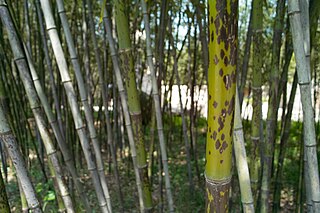
Spotted bamboo refers to several types of bamboo with stems that are mottled by dark spots, sometimes considered to be within the genus Phyllostachys and forms of Phyllostachys bambusoides, also known as teardrop bamboo and as mottled bamboo. Phyllostachys bambusoides forma. lacrima-deae is widely encountered.
The Great Flood of Gun-Yu, also known as the Gun-Yu myth, was a major flood in ancient China that allegedly continued for at least two generations, which resulted in great population displacements among other disasters, such as storms and famine. People left their homes to live on the high hills and mountains, or nest on the trees. According to mythological and historical sources, it is traditionally dated to the third millennium BCE, or about 2300–2200 BCE, during the reign of Emperor Yao.
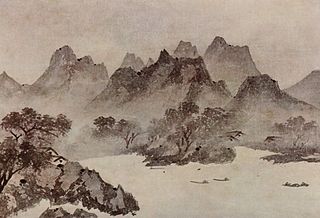
Xiaoxiang poetry is one of the Classical Chinese poetry genres, one which has been practiced for over a thousand years. It is a poetry of scenic wonders, a poetry of officials exiled for their views and beliefs, and a poetry of dissent against submitting to government control. Xiaoxiang poetry is geographically associated with the Xiaoxiang region, around and south of Dongting Lake. The Xiaoxiang genre of literature is often associated with similarly themed Chinese calligraphy and Chinese painting. Famous poets in this genre include Qu Yuan, Song Yu, Jia Yi, Wang Yi, Yu Xin, Shen Quanqi, Zhang Yue, Li Bai, Du Fu, Han Yu, Liu Zongyuan, and Su Shi.
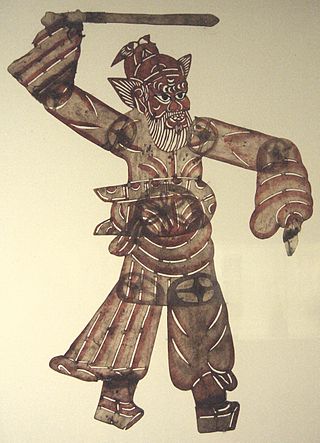
The imperial examination was a civil service examination system in Imperial China designed to select the best potential candidates to serve as administrative officials, for the purpose of recruiting them for the state's bureaucracy. With the avowed purpose of testing and selecting candidates for merit, the examination system markedly influenced various aspects of society and culture in Imperial China, including Chinese mythology.

Geese are an important motif in Chinese poetry. Examples of goose imagery have an important place in Chinese poetry ranging from the Shijing and the Chu Ci poets through the poets of Han poetry and later poets of Tang poetry such as Li Bai, Wang Wei, Du Fu, and the Xiaoxiang poetry, especially in the poetry of the Song dynastic era. Various poetic concepts could be communicated by the inclusion of the imagery of geese in a poem, and the understanding of allusions to a goose or geese can help provide key insights into the poems of Classical Chinese poetry. Chinese sources typically distinguish between two types of geese, the domestic goose, and the wild goose: of the two, the wild goose is the more important for poetry, whether as significant of migratory seasonal change, or as "bearing a message of love from afar", by persons separated by a great distance, or as the "lone goose", bereft of both mate and flock.

The Shuixian Zunwang are five Chinese Deities worshipped as water and sea deities. They have various names in English including the Honorable Water Immortal Kings and the Lords of the Water. All five deities were formerly famous heroes and are related to water in certain ways. They are also believed to protect vessels in transit.
